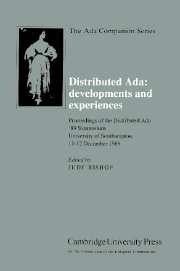 Distributed Ada: Developments and Experiences
Distributed Ada: Developments and Experiences Book contents
- Frontmatter
- Contents
- Preface
- Distributed Ada – the Issues
- Distributed Ada – a Case Study
- Parallel Ada for Symmetrical Multiprocessors
- The York Distributed Ada Project
- From DIADEM to DRAGOON
- Honeywell Distributed Ada – Approach
- Honeywell Distributed Ada – Implementation
- Ada for Tightly Coupled Systems
- A Pragmatic Approach to Distributed Ada for Transputers
- Distributed Ada on Shared Memory Multiprocessors
- The MUMS Multiprocessor Ada Project
- A Portable Common Executable Environment for Ada
- Supporting Reliable Distributed Systems in Ada 9X
Parallel Ada for Symmetrical Multiprocessors
Published online by Cambridge University Press: 13 October 2009
- Frontmatter
- Contents
- Preface
- Distributed Ada – the Issues
- Distributed Ada – a Case Study
- Parallel Ada for Symmetrical Multiprocessors
- The York Distributed Ada Project
- From DIADEM to DRAGOON
- Honeywell Distributed Ada – Approach
- Honeywell Distributed Ada – Implementation
- Ada for Tightly Coupled Systems
- A Pragmatic Approach to Distributed Ada for Transputers
- Distributed Ada on Shared Memory Multiprocessors
- The MUMS Multiprocessor Ada Project
- A Portable Common Executable Environment for Ada
- Supporting Reliable Distributed Systems in Ada 9X
Summary
ABSTRACT
A recent trend in computer engineering has been the replacement of large uniprocessor based proprietary architectures by multiple microprocessor based designs employing various interconnection strategies. While these multiprocessor based systems offer significant performance and economic advantages over uniprocessor systems, not all prospective users are able or willing to adapt their applications to execute as multiple concurrent streams.
The Ada programming language is well suited to multiprocessor systems as it allows the programmer to direct the use of concurrency through the use of the Ada tasking mechanism. The avoidance of automatic distribution of the program by the compiler and the choice of the Ada task as the unit of distribution greatly simplify the development of Ada software for multiprocessor architectures.
For performance reasons, the inter-processor communications path should offer low latency and high transfer rates. Shared memory supports these characteristics and a multiprocessor system, where all memory can be accessed by all processors, has proven to be a suitable platform for a parallel Ada implementation.
This paper discusses the implementation and architecture of a parallel Ada system that allows up to twenty processors to co-execute the same Ada program with true concurrency. Particular attention is given to the design of the Ada runtime and the interface between the runtime and the underlying operating system, as these parts of the system must be “multi-threaded” throughout in order to minimize bottle-necks. The paper concludes with the description of a 1000 MIPS Ada engine currently under development.
- Type
- Chapter
- Information
- Distributed Ada: Developments and ExperiencesProceedings of the Distributed Ada '89 Symposium, University of Southampton, 11–12 December 1989, pp. 58 - 66Publisher: Cambridge University PressPrint publication year: 1990
- 2
- Cited by
